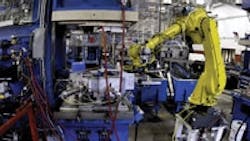Automation Helps Signicast Stay Ahead of the Curve
Customers were thrilled but the competitors were suspicious. In 1993 Signicast Corp. a manufacturer of investment castings, opened its Module 1 manufacturing operation and reduced its production cycle from 30 days to 4.5. "Rumors from our competitors were that we were just stocking inventory and not actually manufacturing, so we opened up our facility and 88 competitors showed up," remembers Bob Schuemann, executive vice president at Signicast.
Although it sounds like a risky move, Schuemann explains that the facility was so far ahead of its time from an automation standpoint that his competitors didn't understand what they were seeing. Their advanced standing, however, didn't stop their momentum and the company later went on to open more facilities. Module 3, which opened in 2003, is the second-most automated custom IC facility in the world, according to the Signicast. It operates with 27 robots. Module 4 later opened in 2006 with 34 robots. Both Modules 3 and 4 bring in $30 million in revenue with 10 to 15 employees per 12-hour shift.
"We automated differently than most others in our industry," Schuemann says. "We looked at the entire flow of the product through our factory rather than the traditional way of looking at how to automate one particular function or area."
The robots are quite advanced as well since Signicast programs them using in-house staff. This allows the company to quickly implement its ongoing continuous-improvement methods and quickly address changes in market demand.
"Increased automation was the answer to reducing labor, but we didn't reduce our workforce. We just deployed them in a more effective manner," he says.
Cross-training proved to be the foundation of effective labor deployment, especially given that the shifts are 12 hours and can become tedious, explains Schuemann. "Every four to six hours employees rotate from one job to another. This keeps everyone informed on how well things are moving through the floor." Success on the floor pays off, he notes, as everyone is part of a profit-sharing bonus plan that is paid quarterly.
See Also
